Supply Chain Management in Construction Industry: A Detailed Report
VerifiedAdded on 2022/08/26
|13
|3784
|21
Report
AI Summary
This report delves into the critical role of supply chain management (SCM) within the construction industry, using Strabag Construction as a case study. It examines the key activities involved in SCM, including materials flow, logistics, and partnerships, emphasizing their impact on cost, efficiency, and project success. The report identifies the specific roles of SCM in construction, such as equipment and materials logistics, and highlights the challenges faced, including order information transparency, variability, and resource management. A proposed supply chain model for improvement is presented, incorporating strategies like supplier development, performance measurement, and benchmarking. The report concludes with recommendations for enhancing SCM practices, aiming to improve integration and coordination within construction projects and improve overall project outcomes. It underscores the need for continuous improvement and investment in training to optimize supply chain performance.

qwertyuiopasdfghjklzxcvbnmqw
ertyuiopasdfghjklzxcvbnmqwert
yuiopasdfghjklzxcvbnmqwertyui
opasdfghjklzxcvbnmqwertyuiop
asdfghjklzxcvbnmqwertyuiopasd
fghjklzxcvbnmqwertyuiopasdfgh
jklzxcvbnmqwertyuiopasdfghjkl
zxcvbnmqwertyuiopasdfghjklzxc
vbnmqwertyuiopasdfghjklzxcvb
nmqwertyuiopasdfghjklzxcvbnm
qwertyuiopasdfghjklzxcvbnmqw
ertyuiopasdfghjklzxcvbnmqwert
yuiopasdfghjklzxcvbnmqwertyui
opasdfghjklzxcvbnmqwertyuiop
asdfghjklzxcvbnmqwertyuiopasd
fghjklzxcvbnmqwertyuiopasdfgh
jklzxcvbnmrtyuiopasdfghjklzxcv
operation, networks, & partnerships
[Type the document subtitle]
1/15/2020
student name
ertyuiopasdfghjklzxcvbnmqwert
yuiopasdfghjklzxcvbnmqwertyui
opasdfghjklzxcvbnmqwertyuiop
asdfghjklzxcvbnmqwertyuiopasd
fghjklzxcvbnmqwertyuiopasdfgh
jklzxcvbnmqwertyuiopasdfghjkl
zxcvbnmqwertyuiopasdfghjklzxc
vbnmqwertyuiopasdfghjklzxcvb
nmqwertyuiopasdfghjklzxcvbnm
qwertyuiopasdfghjklzxcvbnmqw
ertyuiopasdfghjklzxcvbnmqwert
yuiopasdfghjklzxcvbnmqwertyui
opasdfghjklzxcvbnmqwertyuiop
asdfghjklzxcvbnmqwertyuiopasd
fghjklzxcvbnmqwertyuiopasdfgh
jklzxcvbnmrtyuiopasdfghjklzxcv
operation, networks, & partnerships
[Type the document subtitle]
1/15/2020
student name
Paraphrase This Document
Need a fresh take? Get an instant paraphrase of this document with our AI Paraphraser
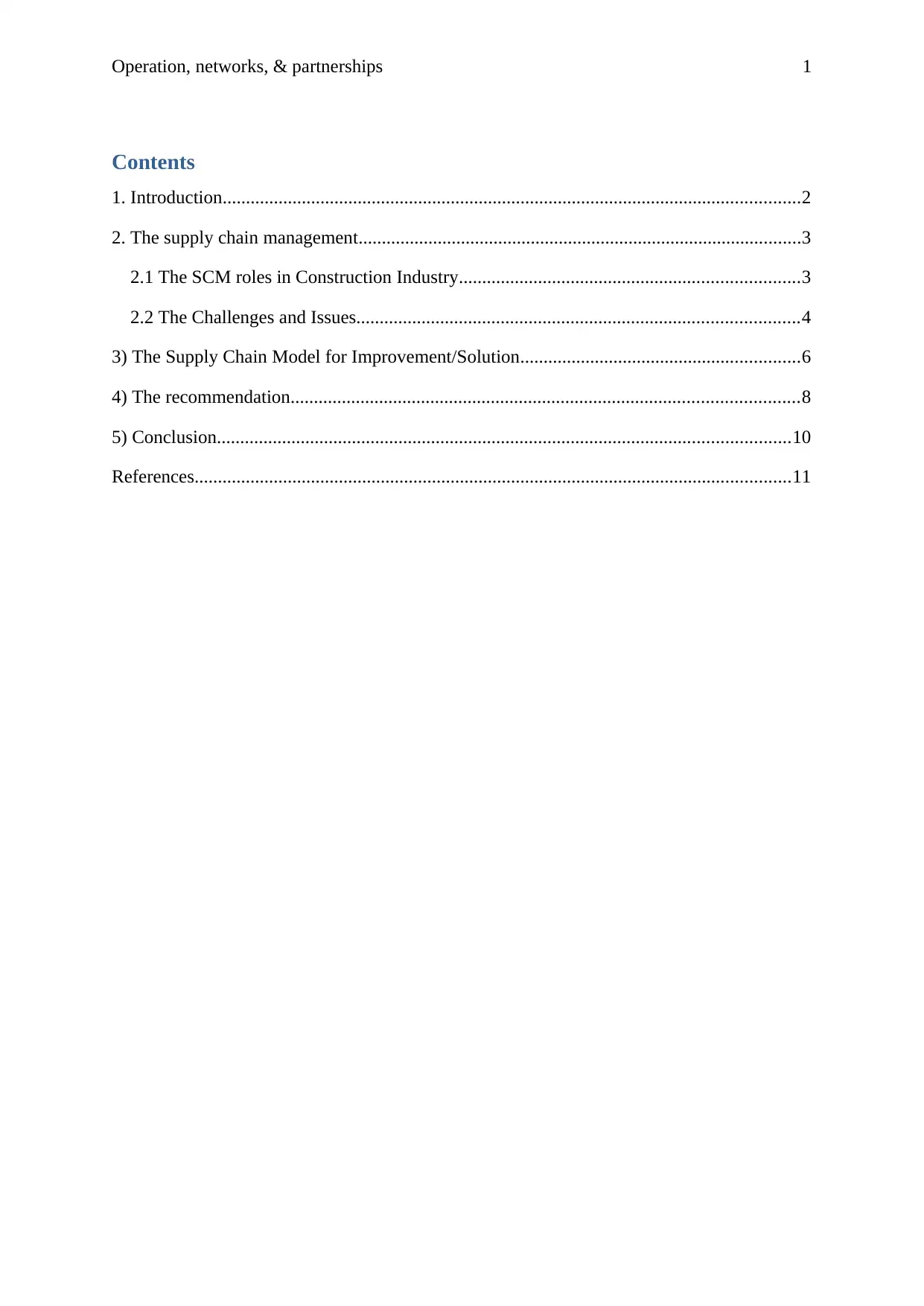
Operation, networks, & partnerships 1
Contents
1. Introduction............................................................................................................................2
2. The supply chain management...............................................................................................3
2.1 The SCM roles in Construction Industry.........................................................................3
2.2 The Challenges and Issues...............................................................................................4
3) The Supply Chain Model for Improvement/Solution............................................................6
4) The recommendation.............................................................................................................8
5) Conclusion...........................................................................................................................10
References................................................................................................................................11
Contents
1. Introduction............................................................................................................................2
2. The supply chain management...............................................................................................3
2.1 The SCM roles in Construction Industry.........................................................................3
2.2 The Challenges and Issues...............................................................................................4
3) The Supply Chain Model for Improvement/Solution............................................................6
4) The recommendation.............................................................................................................8
5) Conclusion...........................................................................................................................10
References................................................................................................................................11
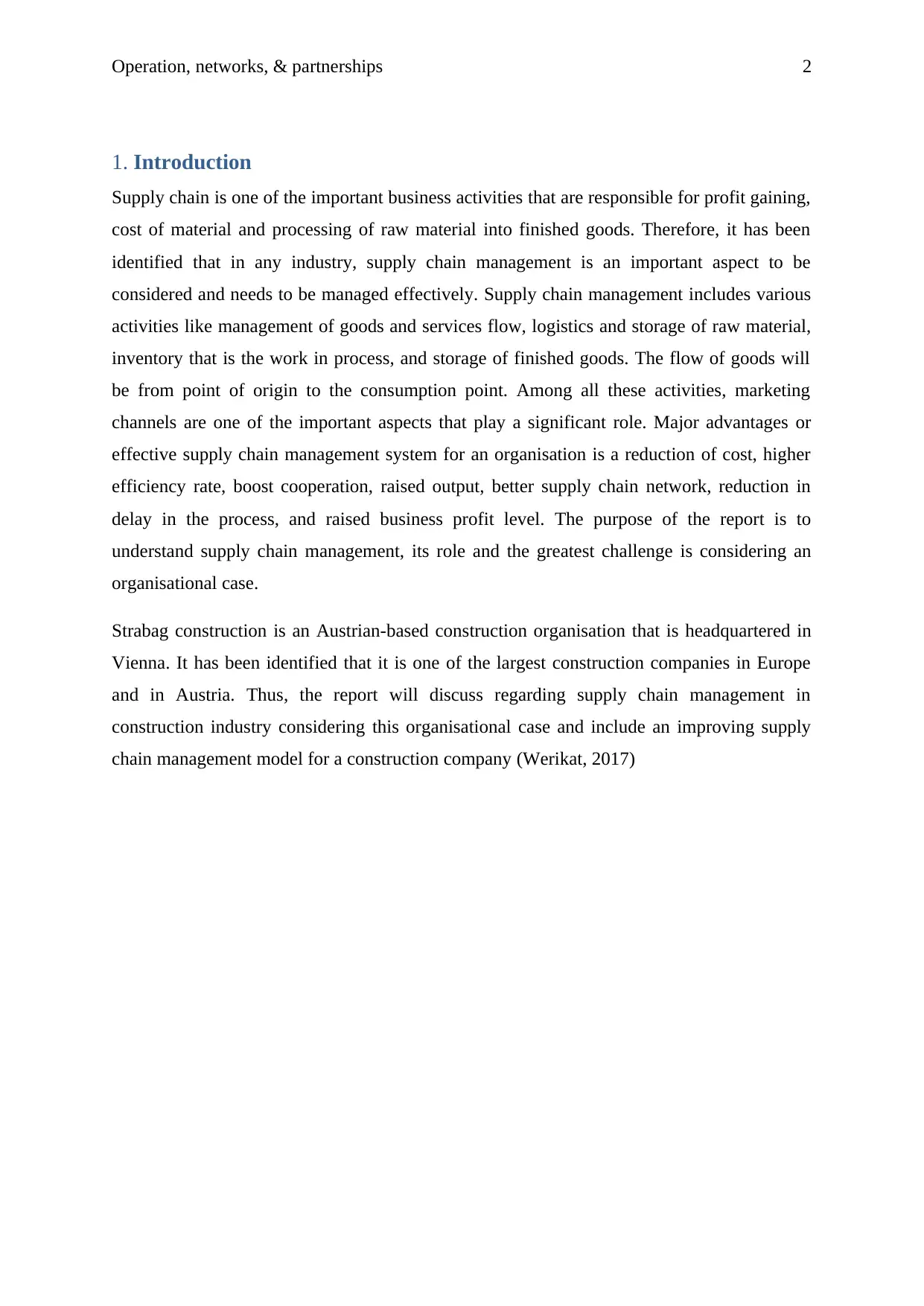
Operation, networks, & partnerships 2
1. Introduction
Supply chain is one of the important business activities that are responsible for profit gaining,
cost of material and processing of raw material into finished goods. Therefore, it has been
identified that in any industry, supply chain management is an important aspect to be
considered and needs to be managed effectively. Supply chain management includes various
activities like management of goods and services flow, logistics and storage of raw material,
inventory that is the work in process, and storage of finished goods. The flow of goods will
be from point of origin to the consumption point. Among all these activities, marketing
channels are one of the important aspects that play a significant role. Major advantages or
effective supply chain management system for an organisation is a reduction of cost, higher
efficiency rate, boost cooperation, raised output, better supply chain network, reduction in
delay in the process, and raised business profit level. The purpose of the report is to
understand supply chain management, its role and the greatest challenge is considering an
organisational case.
Strabag construction is an Austrian-based construction organisation that is headquartered in
Vienna. It has been identified that it is one of the largest construction companies in Europe
and in Austria. Thus, the report will discuss regarding supply chain management in
construction industry considering this organisational case and include an improving supply
chain management model for a construction company (Werikat, 2017)
1. Introduction
Supply chain is one of the important business activities that are responsible for profit gaining,
cost of material and processing of raw material into finished goods. Therefore, it has been
identified that in any industry, supply chain management is an important aspect to be
considered and needs to be managed effectively. Supply chain management includes various
activities like management of goods and services flow, logistics and storage of raw material,
inventory that is the work in process, and storage of finished goods. The flow of goods will
be from point of origin to the consumption point. Among all these activities, marketing
channels are one of the important aspects that play a significant role. Major advantages or
effective supply chain management system for an organisation is a reduction of cost, higher
efficiency rate, boost cooperation, raised output, better supply chain network, reduction in
delay in the process, and raised business profit level. The purpose of the report is to
understand supply chain management, its role and the greatest challenge is considering an
organisational case.
Strabag construction is an Austrian-based construction organisation that is headquartered in
Vienna. It has been identified that it is one of the largest construction companies in Europe
and in Austria. Thus, the report will discuss regarding supply chain management in
construction industry considering this organisational case and include an improving supply
chain management model for a construction company (Werikat, 2017)
⊘ This is a preview!⊘
Do you want full access?
Subscribe today to unlock all pages.

Trusted by 1+ million students worldwide
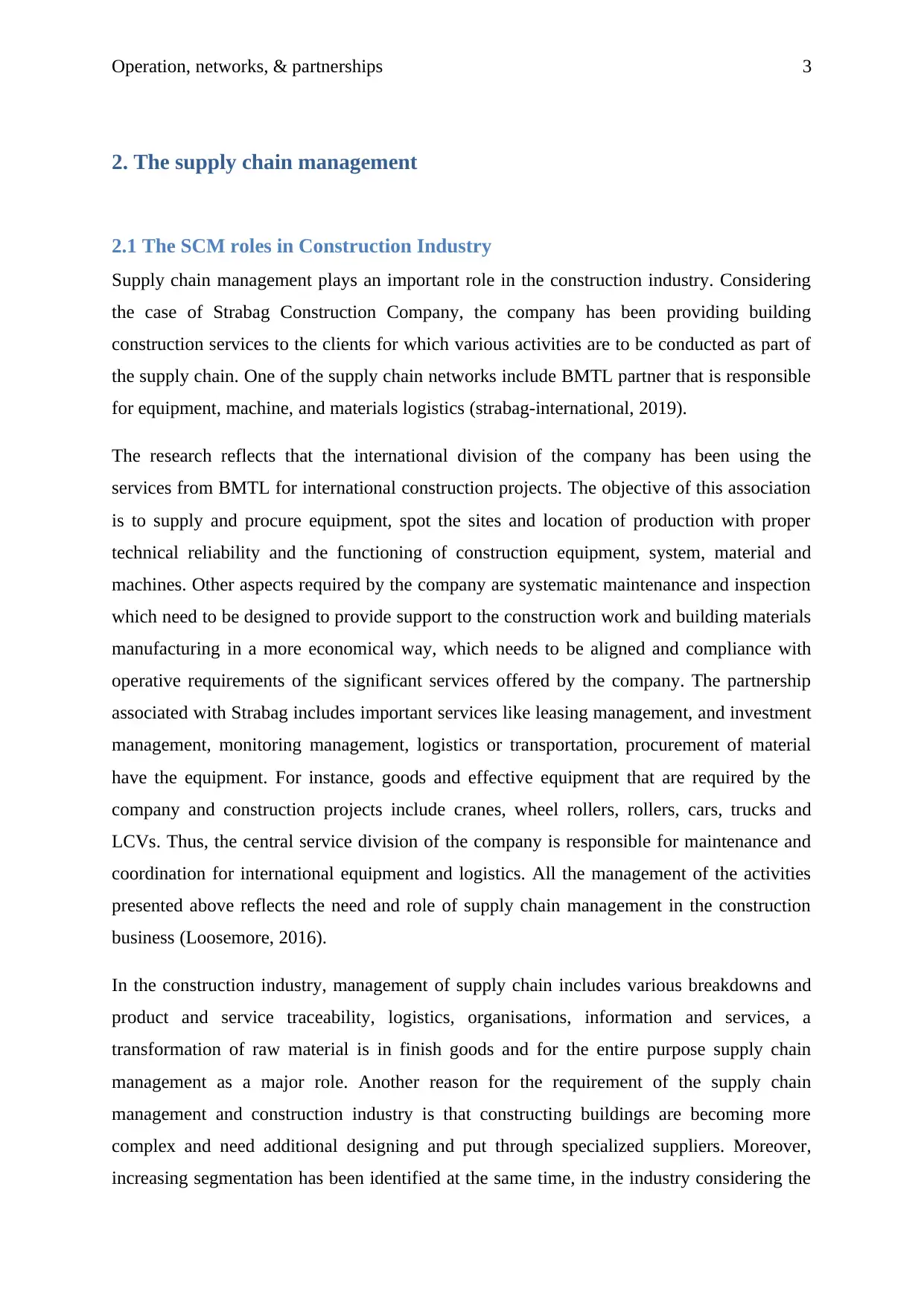
Operation, networks, & partnerships 3
2. The supply chain management
2.1 The SCM roles in Construction Industry
Supply chain management plays an important role in the construction industry. Considering
the case of Strabag Construction Company, the company has been providing building
construction services to the clients for which various activities are to be conducted as part of
the supply chain. One of the supply chain networks include BMTL partner that is responsible
for equipment, machine, and materials logistics (strabag-international, 2019).
The research reflects that the international division of the company has been using the
services from BMTL for international construction projects. The objective of this association
is to supply and procure equipment, spot the sites and location of production with proper
technical reliability and the functioning of construction equipment, system, material and
machines. Other aspects required by the company are systematic maintenance and inspection
which need to be designed to provide support to the construction work and building materials
manufacturing in a more economical way, which needs to be aligned and compliance with
operative requirements of the significant services offered by the company. The partnership
associated with Strabag includes important services like leasing management, and investment
management, monitoring management, logistics or transportation, procurement of material
have the equipment. For instance, goods and effective equipment that are required by the
company and construction projects include cranes, wheel rollers, rollers, cars, trucks and
LCVs. Thus, the central service division of the company is responsible for maintenance and
coordination for international equipment and logistics. All the management of the activities
presented above reflects the need and role of supply chain management in the construction
business (Loosemore, 2016).
In the construction industry, management of supply chain includes various breakdowns and
product and service traceability, logistics, organisations, information and services, a
transformation of raw material is in finish goods and for the entire purpose supply chain
management as a major role. Another reason for the requirement of the supply chain
management and construction industry is that constructing buildings are becoming more
complex and need additional designing and put through specialized suppliers. Moreover,
increasing segmentation has been identified at the same time, in the industry considering the
2. The supply chain management
2.1 The SCM roles in Construction Industry
Supply chain management plays an important role in the construction industry. Considering
the case of Strabag Construction Company, the company has been providing building
construction services to the clients for which various activities are to be conducted as part of
the supply chain. One of the supply chain networks include BMTL partner that is responsible
for equipment, machine, and materials logistics (strabag-international, 2019).
The research reflects that the international division of the company has been using the
services from BMTL for international construction projects. The objective of this association
is to supply and procure equipment, spot the sites and location of production with proper
technical reliability and the functioning of construction equipment, system, material and
machines. Other aspects required by the company are systematic maintenance and inspection
which need to be designed to provide support to the construction work and building materials
manufacturing in a more economical way, which needs to be aligned and compliance with
operative requirements of the significant services offered by the company. The partnership
associated with Strabag includes important services like leasing management, and investment
management, monitoring management, logistics or transportation, procurement of material
have the equipment. For instance, goods and effective equipment that are required by the
company and construction projects include cranes, wheel rollers, rollers, cars, trucks and
LCVs. Thus, the central service division of the company is responsible for maintenance and
coordination for international equipment and logistics. All the management of the activities
presented above reflects the need and role of supply chain management in the construction
business (Loosemore, 2016).
In the construction industry, management of supply chain includes various breakdowns and
product and service traceability, logistics, organisations, information and services, a
transformation of raw material is in finish goods and for the entire purpose supply chain
management as a major role. Another reason for the requirement of the supply chain
management and construction industry is that constructing buildings are becoming more
complex and need additional designing and put through specialized suppliers. Moreover,
increasing segmentation has been identified at the same time, in the industry considering the
Paraphrase This Document
Need a fresh take? Get an instant paraphrase of this document with our AI Paraphraser
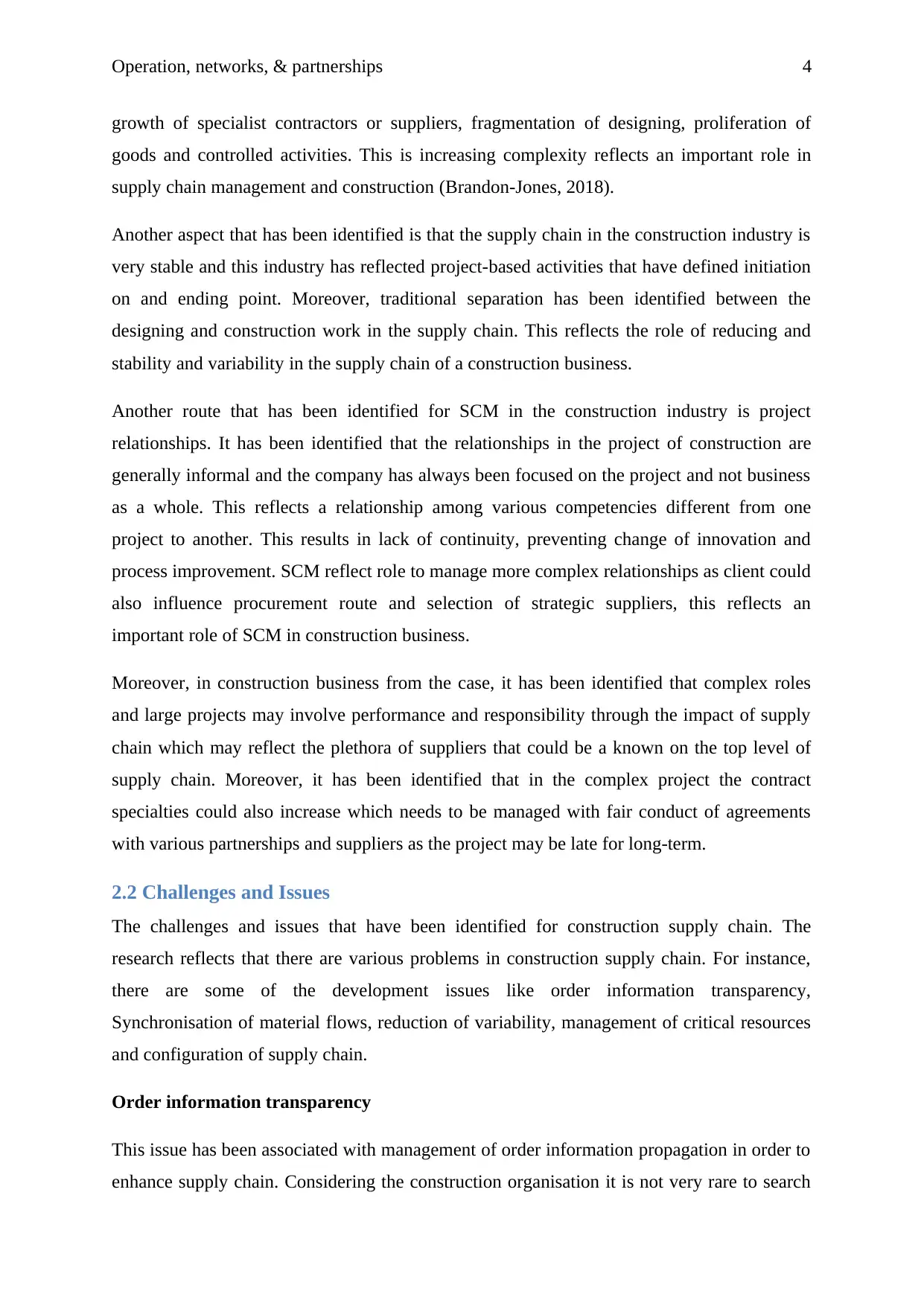
Operation, networks, & partnerships 4
growth of specialist contractors or suppliers, fragmentation of designing, proliferation of
goods and controlled activities. This is increasing complexity reflects an important role in
supply chain management and construction (Brandon-Jones, 2018).
Another aspect that has been identified is that the supply chain in the construction industry is
very stable and this industry has reflected project-based activities that have defined initiation
on and ending point. Moreover, traditional separation has been identified between the
designing and construction work in the supply chain. This reflects the role of reducing and
stability and variability in the supply chain of a construction business.
Another route that has been identified for SCM in the construction industry is project
relationships. It has been identified that the relationships in the project of construction are
generally informal and the company has always been focused on the project and not business
as a whole. This reflects a relationship among various competencies different from one
project to another. This results in lack of continuity, preventing change of innovation and
process improvement. SCM reflect role to manage more complex relationships as client could
also influence procurement route and selection of strategic suppliers, this reflects an
important role of SCM in construction business.
Moreover, in construction business from the case, it has been identified that complex roles
and large projects may involve performance and responsibility through the impact of supply
chain which may reflect the plethora of suppliers that could be a known on the top level of
supply chain. Moreover, it has been identified that in the complex project the contract
specialties could also increase which needs to be managed with fair conduct of agreements
with various partnerships and suppliers as the project may be late for long-term.
2.2 Challenges and Issues
The challenges and issues that have been identified for construction supply chain. The
research reflects that there are various problems in construction supply chain. For instance,
there are some of the development issues like order information transparency,
Synchronisation of material flows, reduction of variability, management of critical resources
and configuration of supply chain.
Order information transparency
This issue has been associated with management of order information propagation in order to
enhance supply chain. Considering the construction organisation it is not very rare to search
growth of specialist contractors or suppliers, fragmentation of designing, proliferation of
goods and controlled activities. This is increasing complexity reflects an important role in
supply chain management and construction (Brandon-Jones, 2018).
Another aspect that has been identified is that the supply chain in the construction industry is
very stable and this industry has reflected project-based activities that have defined initiation
on and ending point. Moreover, traditional separation has been identified between the
designing and construction work in the supply chain. This reflects the role of reducing and
stability and variability in the supply chain of a construction business.
Another route that has been identified for SCM in the construction industry is project
relationships. It has been identified that the relationships in the project of construction are
generally informal and the company has always been focused on the project and not business
as a whole. This reflects a relationship among various competencies different from one
project to another. This results in lack of continuity, preventing change of innovation and
process improvement. SCM reflect role to manage more complex relationships as client could
also influence procurement route and selection of strategic suppliers, this reflects an
important role of SCM in construction business.
Moreover, in construction business from the case, it has been identified that complex roles
and large projects may involve performance and responsibility through the impact of supply
chain which may reflect the plethora of suppliers that could be a known on the top level of
supply chain. Moreover, it has been identified that in the complex project the contract
specialties could also increase which needs to be managed with fair conduct of agreements
with various partnerships and suppliers as the project may be late for long-term.
2.2 Challenges and Issues
The challenges and issues that have been identified for construction supply chain. The
research reflects that there are various problems in construction supply chain. For instance,
there are some of the development issues like order information transparency,
Synchronisation of material flows, reduction of variability, management of critical resources
and configuration of supply chain.
Order information transparency
This issue has been associated with management of order information propagation in order to
enhance supply chain. Considering the construction organisation it is not very rare to search
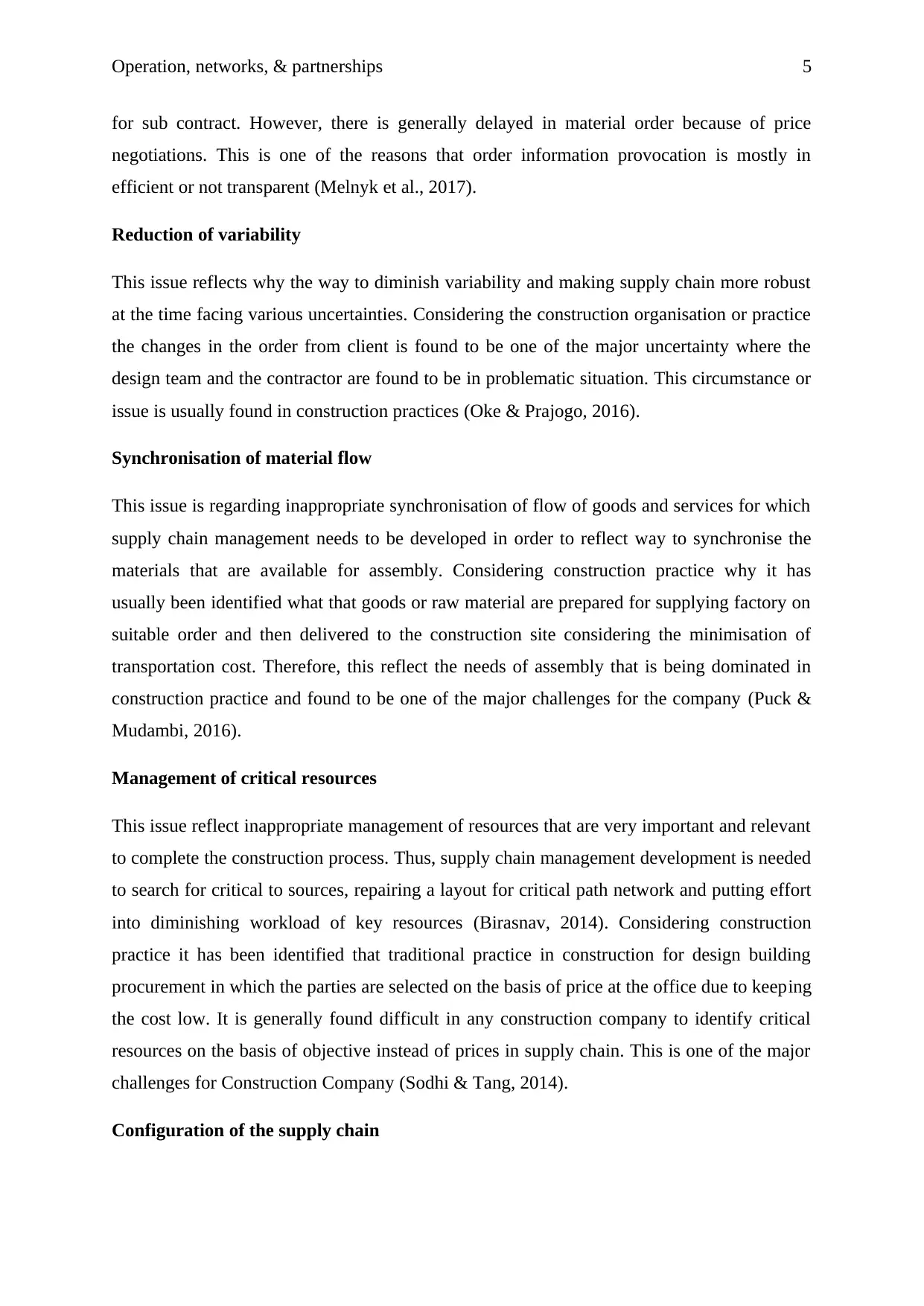
Operation, networks, & partnerships 5
for sub contract. However, there is generally delayed in material order because of price
negotiations. This is one of the reasons that order information provocation is mostly in
efficient or not transparent (Melnyk et al., 2017).
Reduction of variability
This issue reflects why the way to diminish variability and making supply chain more robust
at the time facing various uncertainties. Considering the construction organisation or practice
the changes in the order from client is found to be one of the major uncertainty where the
design team and the contractor are found to be in problematic situation. This circumstance or
issue is usually found in construction practices (Oke & Prajogo, 2016).
Synchronisation of material flow
This issue is regarding inappropriate synchronisation of flow of goods and services for which
supply chain management needs to be developed in order to reflect way to synchronise the
materials that are available for assembly. Considering construction practice why it has
usually been identified what that goods or raw material are prepared for supplying factory on
suitable order and then delivered to the construction site considering the minimisation of
transportation cost. Therefore, this reflect the needs of assembly that is being dominated in
construction practice and found to be one of the major challenges for the company (Puck &
Mudambi, 2016).
Management of critical resources
This issue reflect inappropriate management of resources that are very important and relevant
to complete the construction process. Thus, supply chain management development is needed
to search for critical to sources, repairing a layout for critical path network and putting effort
into diminishing workload of key resources (Birasnav, 2014). Considering construction
practice it has been identified that traditional practice in construction for design building
procurement in which the parties are selected on the basis of price at the office due to keeping
the cost low. It is generally found difficult in any construction company to identify critical
resources on the basis of objective instead of prices in supply chain. This is one of the major
challenges for Construction Company (Sodhi & Tang, 2014).
Configuration of the supply chain
for sub contract. However, there is generally delayed in material order because of price
negotiations. This is one of the reasons that order information provocation is mostly in
efficient or not transparent (Melnyk et al., 2017).
Reduction of variability
This issue reflects why the way to diminish variability and making supply chain more robust
at the time facing various uncertainties. Considering the construction organisation or practice
the changes in the order from client is found to be one of the major uncertainty where the
design team and the contractor are found to be in problematic situation. This circumstance or
issue is usually found in construction practices (Oke & Prajogo, 2016).
Synchronisation of material flow
This issue is regarding inappropriate synchronisation of flow of goods and services for which
supply chain management needs to be developed in order to reflect way to synchronise the
materials that are available for assembly. Considering construction practice why it has
usually been identified what that goods or raw material are prepared for supplying factory on
suitable order and then delivered to the construction site considering the minimisation of
transportation cost. Therefore, this reflect the needs of assembly that is being dominated in
construction practice and found to be one of the major challenges for the company (Puck &
Mudambi, 2016).
Management of critical resources
This issue reflect inappropriate management of resources that are very important and relevant
to complete the construction process. Thus, supply chain management development is needed
to search for critical to sources, repairing a layout for critical path network and putting effort
into diminishing workload of key resources (Birasnav, 2014). Considering construction
practice it has been identified that traditional practice in construction for design building
procurement in which the parties are selected on the basis of price at the office due to keeping
the cost low. It is generally found difficult in any construction company to identify critical
resources on the basis of objective instead of prices in supply chain. This is one of the major
challenges for Construction Company (Sodhi & Tang, 2014).
Configuration of the supply chain
⊘ This is a preview!⊘
Do you want full access?
Subscribe today to unlock all pages.

Trusted by 1+ million students worldwide
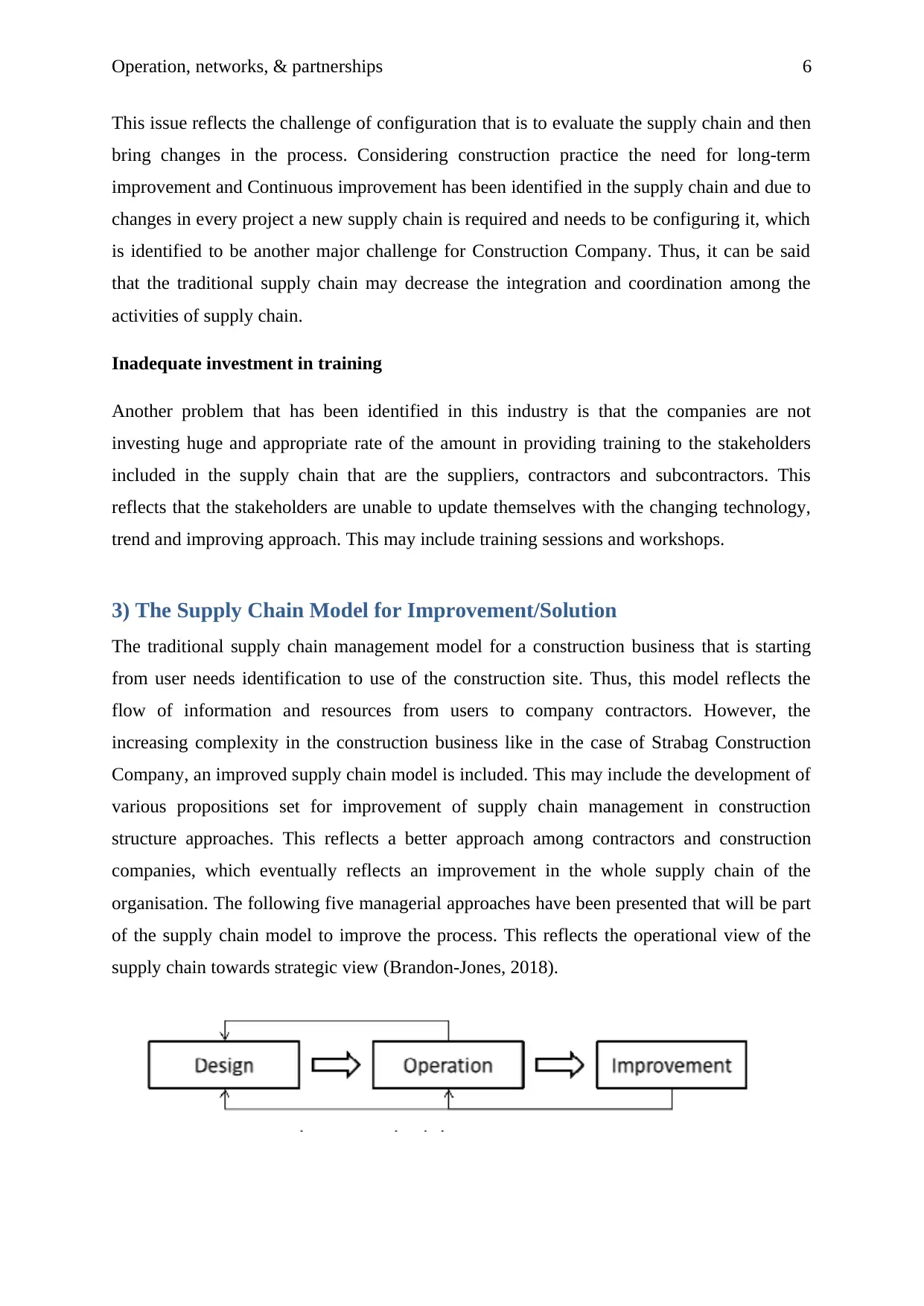
Operation, networks, & partnerships 6
This issue reflects the challenge of configuration that is to evaluate the supply chain and then
bring changes in the process. Considering construction practice the need for long-term
improvement and Continuous improvement has been identified in the supply chain and due to
changes in every project a new supply chain is required and needs to be configuring it, which
is identified to be another major challenge for Construction Company. Thus, it can be said
that the traditional supply chain may decrease the integration and coordination among the
activities of supply chain.
Inadequate investment in training
Another problem that has been identified in this industry is that the companies are not
investing huge and appropriate rate of the amount in providing training to the stakeholders
included in the supply chain that are the suppliers, contractors and subcontractors. This
reflects that the stakeholders are unable to update themselves with the changing technology,
trend and improving approach. This may include training sessions and workshops.
3) The Supply Chain Model for Improvement/Solution
The traditional supply chain management model for a construction business that is starting
from user needs identification to use of the construction site. Thus, this model reflects the
flow of information and resources from users to company contractors. However, the
increasing complexity in the construction business like in the case of Strabag Construction
Company, an improved supply chain model is included. This may include the development of
various propositions set for improvement of supply chain management in construction
structure approaches. This reflects a better approach among contractors and construction
companies, which eventually reflects an improvement in the whole supply chain of the
organisation. The following five managerial approaches have been presented that will be part
of the supply chain model to improve the process. This reflects the operational view of the
supply chain towards strategic view (Brandon-Jones, 2018).
This issue reflects the challenge of configuration that is to evaluate the supply chain and then
bring changes in the process. Considering construction practice the need for long-term
improvement and Continuous improvement has been identified in the supply chain and due to
changes in every project a new supply chain is required and needs to be configuring it, which
is identified to be another major challenge for Construction Company. Thus, it can be said
that the traditional supply chain may decrease the integration and coordination among the
activities of supply chain.
Inadequate investment in training
Another problem that has been identified in this industry is that the companies are not
investing huge and appropriate rate of the amount in providing training to the stakeholders
included in the supply chain that are the suppliers, contractors and subcontractors. This
reflects that the stakeholders are unable to update themselves with the changing technology,
trend and improving approach. This may include training sessions and workshops.
3) The Supply Chain Model for Improvement/Solution
The traditional supply chain management model for a construction business that is starting
from user needs identification to use of the construction site. Thus, this model reflects the
flow of information and resources from users to company contractors. However, the
increasing complexity in the construction business like in the case of Strabag Construction
Company, an improved supply chain model is included. This may include the development of
various propositions set for improvement of supply chain management in construction
structure approaches. This reflects a better approach among contractors and construction
companies, which eventually reflects an improvement in the whole supply chain of the
organisation. The following five managerial approaches have been presented that will be part
of the supply chain model to improve the process. This reflects the operational view of the
supply chain towards strategic view (Brandon-Jones, 2018).
Paraphrase This Document
Need a fresh take? Get an instant paraphrase of this document with our AI Paraphraser
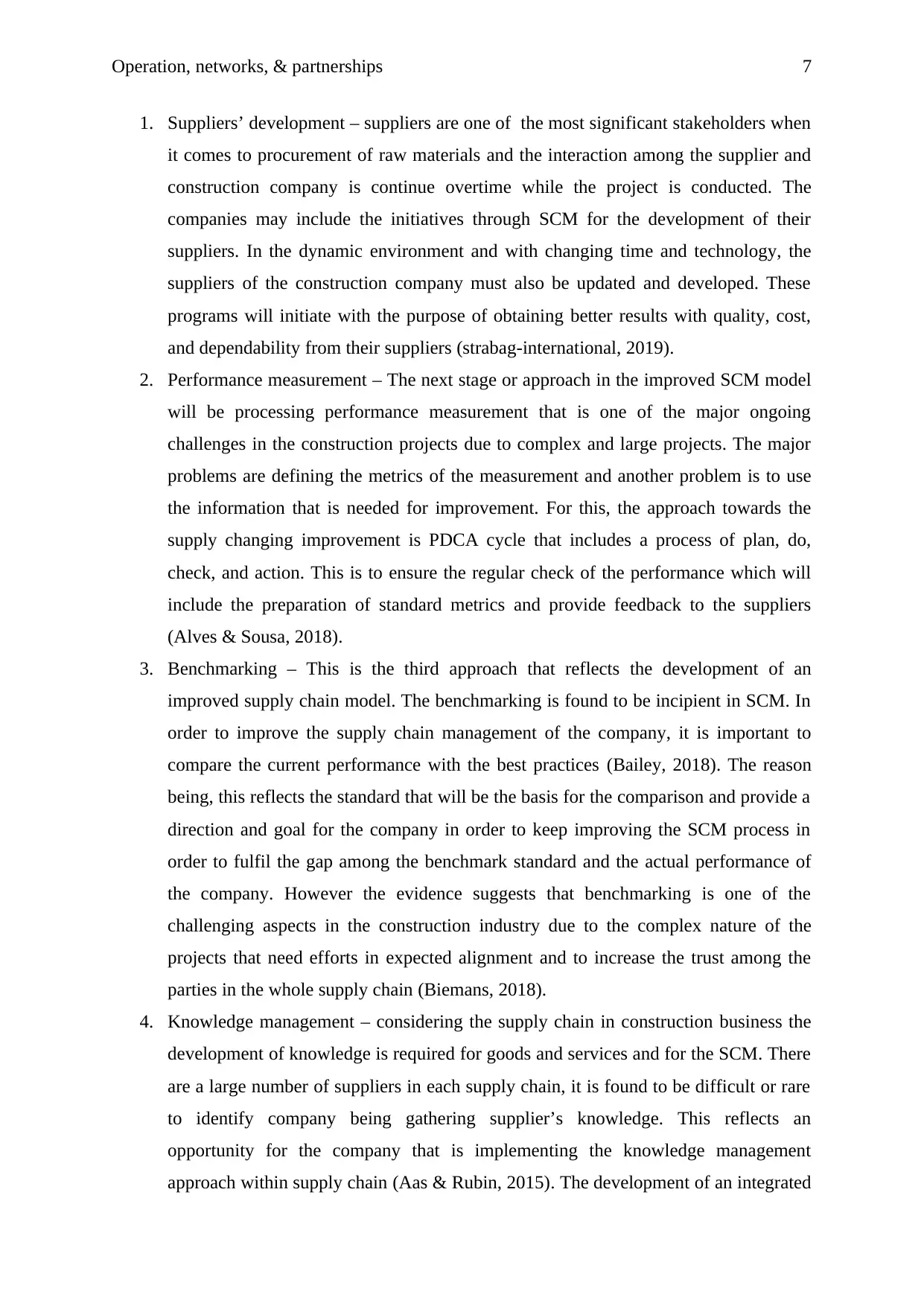
Operation, networks, & partnerships 7
1. Suppliers’ development – suppliers are one of the most significant stakeholders when
it comes to procurement of raw materials and the interaction among the supplier and
construction company is continue overtime while the project is conducted. The
companies may include the initiatives through SCM for the development of their
suppliers. In the dynamic environment and with changing time and technology, the
suppliers of the construction company must also be updated and developed. These
programs will initiate with the purpose of obtaining better results with quality, cost,
and dependability from their suppliers (strabag-international, 2019).
2. Performance measurement – The next stage or approach in the improved SCM model
will be processing performance measurement that is one of the major ongoing
challenges in the construction projects due to complex and large projects. The major
problems are defining the metrics of the measurement and another problem is to use
the information that is needed for improvement. For this, the approach towards the
supply changing improvement is PDCA cycle that includes a process of plan, do,
check, and action. This is to ensure the regular check of the performance which will
include the preparation of standard metrics and provide feedback to the suppliers
(Alves & Sousa, 2018).
3. Benchmarking – This is the third approach that reflects the development of an
improved supply chain model. The benchmarking is found to be incipient in SCM. In
order to improve the supply chain management of the company, it is important to
compare the current performance with the best practices (Bailey, 2018). The reason
being, this reflects the standard that will be the basis for the comparison and provide a
direction and goal for the company in order to keep improving the SCM process in
order to fulfil the gap among the benchmark standard and the actual performance of
the company. However the evidence suggests that benchmarking is one of the
challenging aspects in the construction industry due to the complex nature of the
projects that need efforts in expected alignment and to increase the trust among the
parties in the whole supply chain (Biemans, 2018).
4. Knowledge management – considering the supply chain in construction business the
development of knowledge is required for goods and services and for the SCM. There
are a large number of suppliers in each supply chain, it is found to be difficult or rare
to identify company being gathering supplier’s knowledge. This reflects an
opportunity for the company that is implementing the knowledge management
approach within supply chain (Aas & Rubin, 2015). The development of an integrated
1. Suppliers’ development – suppliers are one of the most significant stakeholders when
it comes to procurement of raw materials and the interaction among the supplier and
construction company is continue overtime while the project is conducted. The
companies may include the initiatives through SCM for the development of their
suppliers. In the dynamic environment and with changing time and technology, the
suppliers of the construction company must also be updated and developed. These
programs will initiate with the purpose of obtaining better results with quality, cost,
and dependability from their suppliers (strabag-international, 2019).
2. Performance measurement – The next stage or approach in the improved SCM model
will be processing performance measurement that is one of the major ongoing
challenges in the construction projects due to complex and large projects. The major
problems are defining the metrics of the measurement and another problem is to use
the information that is needed for improvement. For this, the approach towards the
supply changing improvement is PDCA cycle that includes a process of plan, do,
check, and action. This is to ensure the regular check of the performance which will
include the preparation of standard metrics and provide feedback to the suppliers
(Alves & Sousa, 2018).
3. Benchmarking – This is the third approach that reflects the development of an
improved supply chain model. The benchmarking is found to be incipient in SCM. In
order to improve the supply chain management of the company, it is important to
compare the current performance with the best practices (Bailey, 2018). The reason
being, this reflects the standard that will be the basis for the comparison and provide a
direction and goal for the company in order to keep improving the SCM process in
order to fulfil the gap among the benchmark standard and the actual performance of
the company. However the evidence suggests that benchmarking is one of the
challenging aspects in the construction industry due to the complex nature of the
projects that need efforts in expected alignment and to increase the trust among the
parties in the whole supply chain (Biemans, 2018).
4. Knowledge management – considering the supply chain in construction business the
development of knowledge is required for goods and services and for the SCM. There
are a large number of suppliers in each supply chain, it is found to be difficult or rare
to identify company being gathering supplier’s knowledge. This reflects an
opportunity for the company that is implementing the knowledge management
approach within supply chain (Aas & Rubin, 2015). The development of an integrated
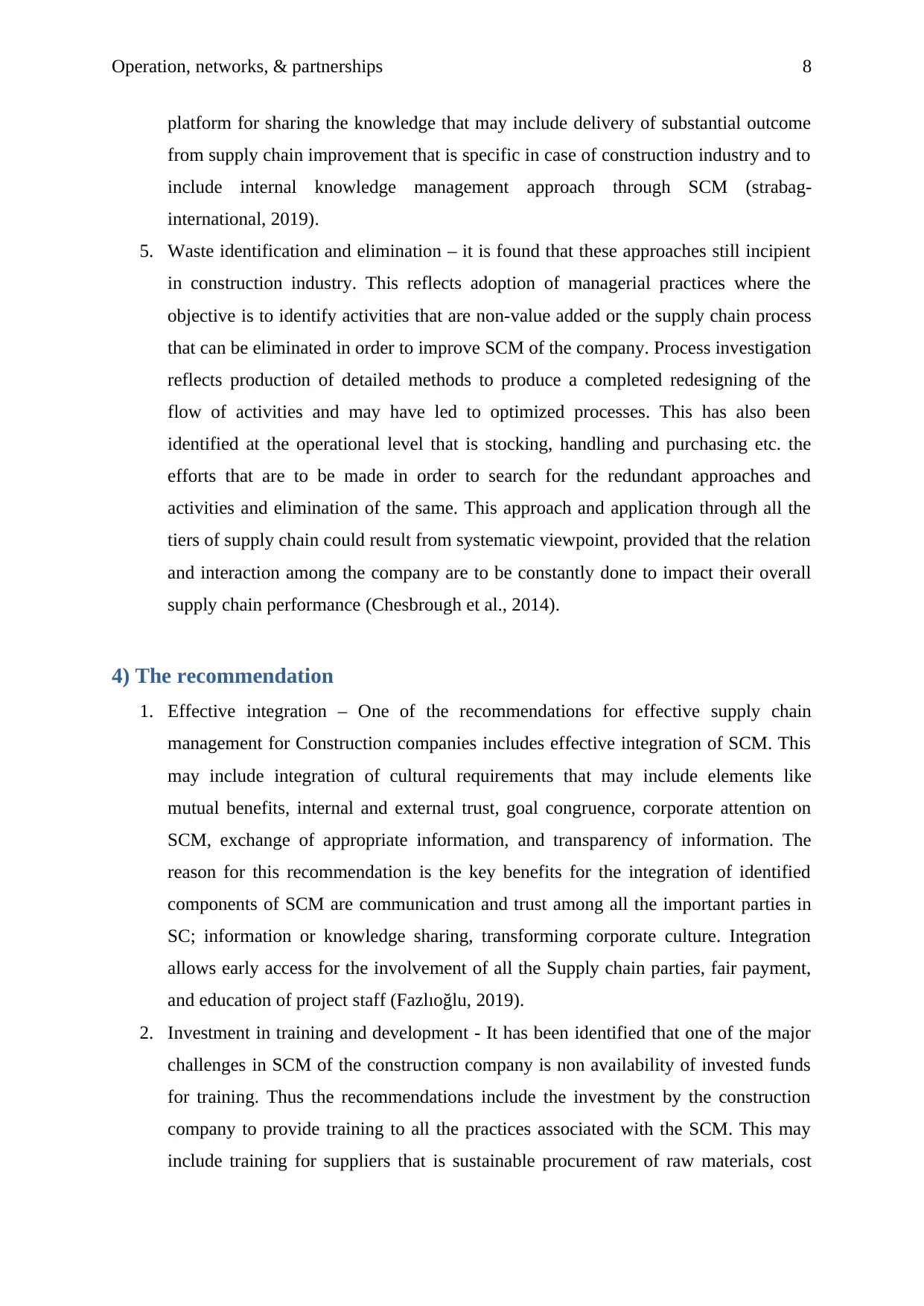
Operation, networks, & partnerships 8
platform for sharing the knowledge that may include delivery of substantial outcome
from supply chain improvement that is specific in case of construction industry and to
include internal knowledge management approach through SCM (strabag-
international, 2019).
5. Waste identification and elimination – it is found that these approaches still incipient
in construction industry. This reflects adoption of managerial practices where the
objective is to identify activities that are non-value added or the supply chain process
that can be eliminated in order to improve SCM of the company. Process investigation
reflects production of detailed methods to produce a completed redesigning of the
flow of activities and may have led to optimized processes. This has also been
identified at the operational level that is stocking, handling and purchasing etc. the
efforts that are to be made in order to search for the redundant approaches and
activities and elimination of the same. This approach and application through all the
tiers of supply chain could result from systematic viewpoint, provided that the relation
and interaction among the company are to be constantly done to impact their overall
supply chain performance (Chesbrough et al., 2014).
4) The recommendation
1. Effective integration – One of the recommendations for effective supply chain
management for Construction companies includes effective integration of SCM. This
may include integration of cultural requirements that may include elements like
mutual benefits, internal and external trust, goal congruence, corporate attention on
SCM, exchange of appropriate information, and transparency of information. The
reason for this recommendation is the key benefits for the integration of identified
components of SCM are communication and trust among all the important parties in
SC; information or knowledge sharing, transforming corporate culture. Integration
allows early access for the involvement of all the Supply chain parties, fair payment,
and education of project staff (Fazlıoğlu, 2019).
2. Investment in training and development - It has been identified that one of the major
challenges in SCM of the construction company is non availability of invested funds
for training. Thus the recommendations include the investment by the construction
company to provide training to all the practices associated with the SCM. This may
include training for suppliers that is sustainable procurement of raw materials, cost
platform for sharing the knowledge that may include delivery of substantial outcome
from supply chain improvement that is specific in case of construction industry and to
include internal knowledge management approach through SCM (strabag-
international, 2019).
5. Waste identification and elimination – it is found that these approaches still incipient
in construction industry. This reflects adoption of managerial practices where the
objective is to identify activities that are non-value added or the supply chain process
that can be eliminated in order to improve SCM of the company. Process investigation
reflects production of detailed methods to produce a completed redesigning of the
flow of activities and may have led to optimized processes. This has also been
identified at the operational level that is stocking, handling and purchasing etc. the
efforts that are to be made in order to search for the redundant approaches and
activities and elimination of the same. This approach and application through all the
tiers of supply chain could result from systematic viewpoint, provided that the relation
and interaction among the company are to be constantly done to impact their overall
supply chain performance (Chesbrough et al., 2014).
4) The recommendation
1. Effective integration – One of the recommendations for effective supply chain
management for Construction companies includes effective integration of SCM. This
may include integration of cultural requirements that may include elements like
mutual benefits, internal and external trust, goal congruence, corporate attention on
SCM, exchange of appropriate information, and transparency of information. The
reason for this recommendation is the key benefits for the integration of identified
components of SCM are communication and trust among all the important parties in
SC; information or knowledge sharing, transforming corporate culture. Integration
allows early access for the involvement of all the Supply chain parties, fair payment,
and education of project staff (Fazlıoğlu, 2019).
2. Investment in training and development - It has been identified that one of the major
challenges in SCM of the construction company is non availability of invested funds
for training. Thus the recommendations include the investment by the construction
company to provide training to all the practices associated with the SCM. This may
include training for suppliers that is sustainable procurement of raw materials, cost
⊘ This is a preview!⊘
Do you want full access?
Subscribe today to unlock all pages.

Trusted by 1+ million students worldwide
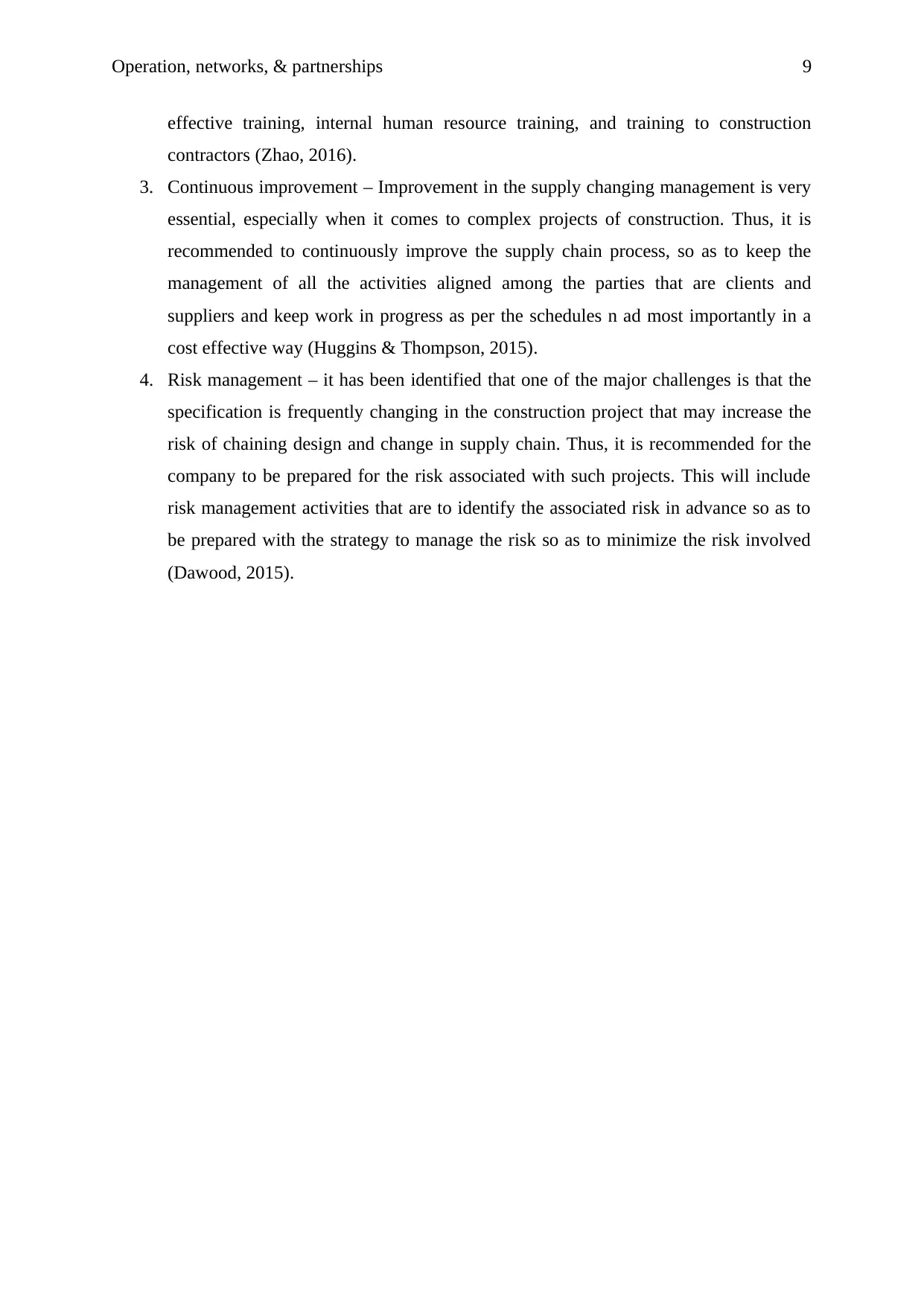
Operation, networks, & partnerships 9
effective training, internal human resource training, and training to construction
contractors (Zhao, 2016).
3. Continuous improvement – Improvement in the supply changing management is very
essential, especially when it comes to complex projects of construction. Thus, it is
recommended to continuously improve the supply chain process, so as to keep the
management of all the activities aligned among the parties that are clients and
suppliers and keep work in progress as per the schedules n ad most importantly in a
cost effective way (Huggins & Thompson, 2015).
4. Risk management – it has been identified that one of the major challenges is that the
specification is frequently changing in the construction project that may increase the
risk of chaining design and change in supply chain. Thus, it is recommended for the
company to be prepared for the risk associated with such projects. This will include
risk management activities that are to identify the associated risk in advance so as to
be prepared with the strategy to manage the risk so as to minimize the risk involved
(Dawood, 2015).
effective training, internal human resource training, and training to construction
contractors (Zhao, 2016).
3. Continuous improvement – Improvement in the supply changing management is very
essential, especially when it comes to complex projects of construction. Thus, it is
recommended to continuously improve the supply chain process, so as to keep the
management of all the activities aligned among the parties that are clients and
suppliers and keep work in progress as per the schedules n ad most importantly in a
cost effective way (Huggins & Thompson, 2015).
4. Risk management – it has been identified that one of the major challenges is that the
specification is frequently changing in the construction project that may increase the
risk of chaining design and change in supply chain. Thus, it is recommended for the
company to be prepared for the risk associated with such projects. This will include
risk management activities that are to identify the associated risk in advance so as to
be prepared with the strategy to manage the risk so as to minimize the risk involved
(Dawood, 2015).
Paraphrase This Document
Need a fresh take? Get an instant paraphrase of this document with our AI Paraphraser
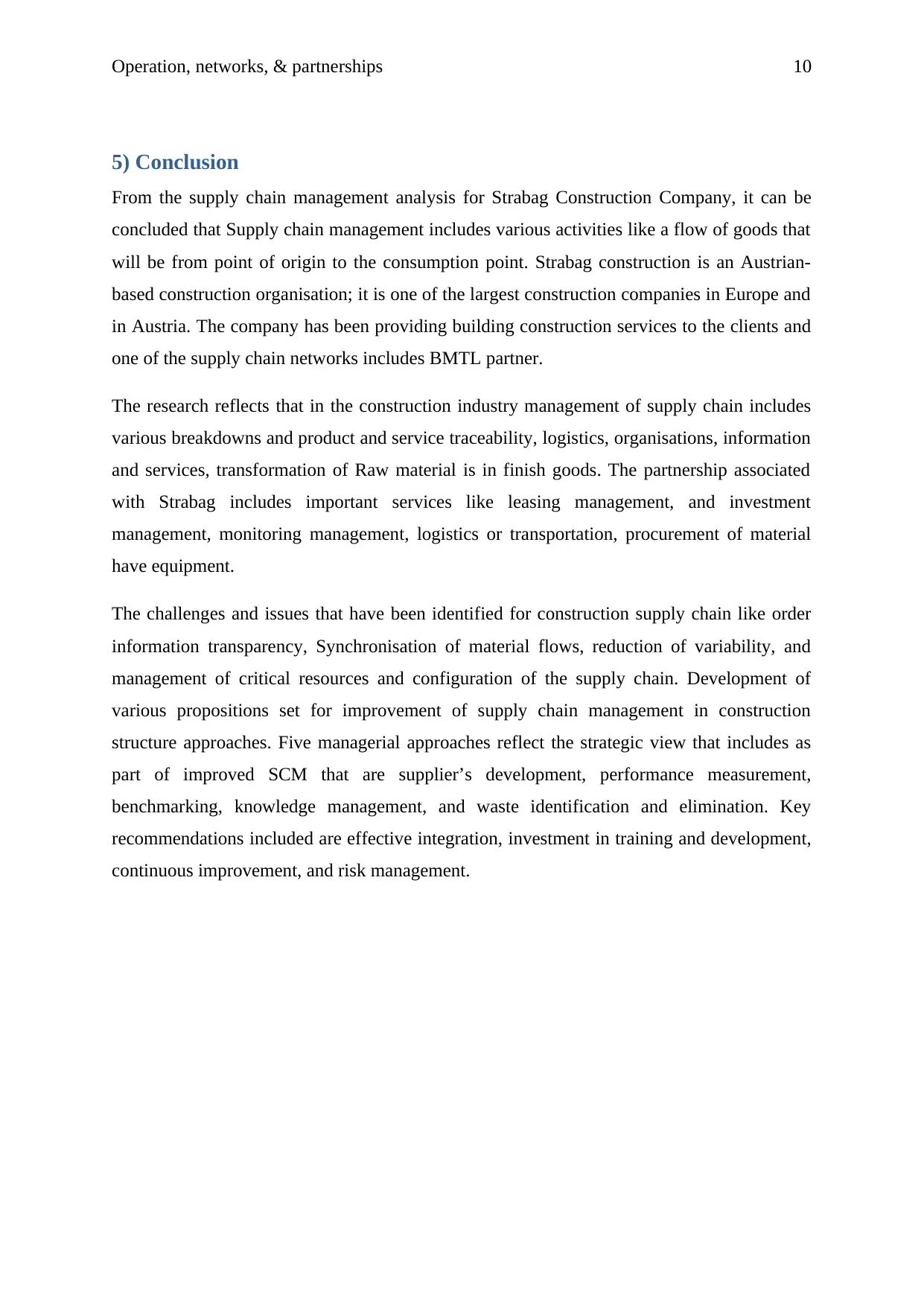
Operation, networks, & partnerships 10
5) Conclusion
From the supply chain management analysis for Strabag Construction Company, it can be
concluded that Supply chain management includes various activities like a flow of goods that
will be from point of origin to the consumption point. Strabag construction is an Austrian-
based construction organisation; it is one of the largest construction companies in Europe and
in Austria. The company has been providing building construction services to the clients and
one of the supply chain networks includes BMTL partner.
The research reflects that in the construction industry management of supply chain includes
various breakdowns and product and service traceability, logistics, organisations, information
and services, transformation of Raw material is in finish goods. The partnership associated
with Strabag includes important services like leasing management, and investment
management, monitoring management, logistics or transportation, procurement of material
have equipment.
The challenges and issues that have been identified for construction supply chain like order
information transparency, Synchronisation of material flows, reduction of variability, and
management of critical resources and configuration of the supply chain. Development of
various propositions set for improvement of supply chain management in construction
structure approaches. Five managerial approaches reflect the strategic view that includes as
part of improved SCM that are supplier’s development, performance measurement,
benchmarking, knowledge management, and waste identification and elimination. Key
recommendations included are effective integration, investment in training and development,
continuous improvement, and risk management.
5) Conclusion
From the supply chain management analysis for Strabag Construction Company, it can be
concluded that Supply chain management includes various activities like a flow of goods that
will be from point of origin to the consumption point. Strabag construction is an Austrian-
based construction organisation; it is one of the largest construction companies in Europe and
in Austria. The company has been providing building construction services to the clients and
one of the supply chain networks includes BMTL partner.
The research reflects that in the construction industry management of supply chain includes
various breakdowns and product and service traceability, logistics, organisations, information
and services, transformation of Raw material is in finish goods. The partnership associated
with Strabag includes important services like leasing management, and investment
management, monitoring management, logistics or transportation, procurement of material
have equipment.
The challenges and issues that have been identified for construction supply chain like order
information transparency, Synchronisation of material flows, reduction of variability, and
management of critical resources and configuration of the supply chain. Development of
various propositions set for improvement of supply chain management in construction
structure approaches. Five managerial approaches reflect the strategic view that includes as
part of improved SCM that are supplier’s development, performance measurement,
benchmarking, knowledge management, and waste identification and elimination. Key
recommendations included are effective integration, investment in training and development,
continuous improvement, and risk management.
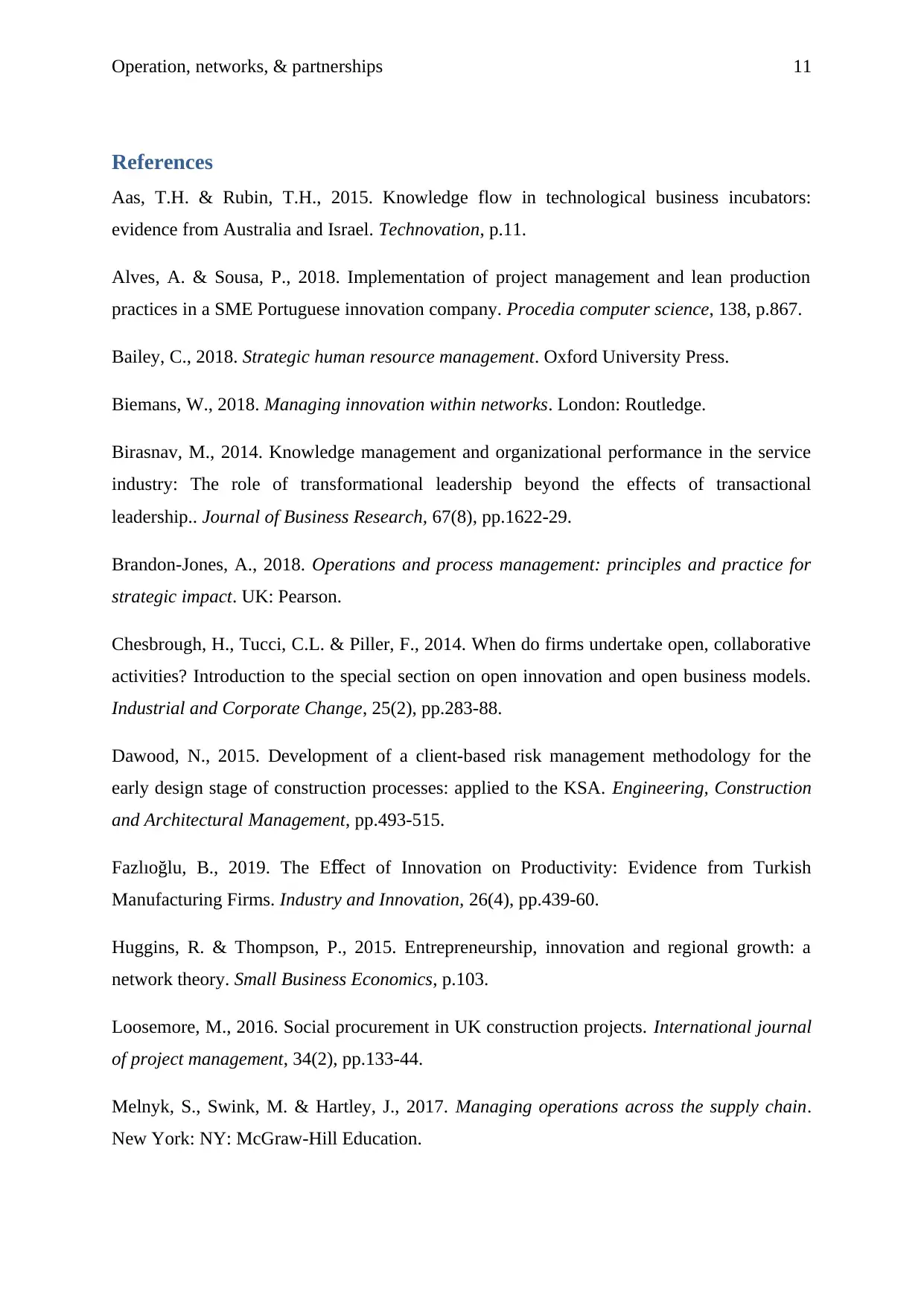
Operation, networks, & partnerships 11
References
Aas, T.H. & Rubin, T.H., 2015. Knowledge flow in technological business incubators:
evidence from Australia and Israel. Technovation, p.11.
Alves, A. & Sousa, P., 2018. Implementation of project management and lean production
practices in a SME Portuguese innovation company. Procedia computer science, 138, p.867.
Bailey, C., 2018. Strategic human resource management. Oxford University Press.
Biemans, W., 2018. Managing innovation within networks. London: Routledge.
Birasnav, M., 2014. Knowledge management and organizational performance in the service
industry: The role of transformational leadership beyond the effects of transactional
leadership.. Journal of Business Research, 67(8), pp.1622-29.
Brandon-Jones, A., 2018. Operations and process management: principles and practice for
strategic impact. UK: Pearson.
Chesbrough, H., Tucci, C.L. & Piller, F., 2014. When do firms undertake open, collaborative
activities? Introduction to the special section on open innovation and open business models.
Industrial and Corporate Change, 25(2), pp.283-88.
Dawood, N., 2015. Development of a client-based risk management methodology for the
early design stage of construction processes: applied to the KSA. Engineering, Construction
and Architectural Management, pp.493-515.
Fazlıoğlu, B., 2019. The E ect of Innovation on Productivity: Evidence from Turkishff
Manufacturing Firms. Industry and Innovation, 26(4), pp.439-60.
Huggins, R. & Thompson, P., 2015. Entrepreneurship, innovation and regional growth: a
network theory. Small Business Economics, p.103.
Loosemore, M., 2016. Social procurement in UK construction projects. International journal
of project management, 34(2), pp.133-44.
Melnyk, S., Swink, M. & Hartley, J., 2017. Managing operations across the supply chain.
New York: NY: McGraw-Hill Education.
References
Aas, T.H. & Rubin, T.H., 2015. Knowledge flow in technological business incubators:
evidence from Australia and Israel. Technovation, p.11.
Alves, A. & Sousa, P., 2018. Implementation of project management and lean production
practices in a SME Portuguese innovation company. Procedia computer science, 138, p.867.
Bailey, C., 2018. Strategic human resource management. Oxford University Press.
Biemans, W., 2018. Managing innovation within networks. London: Routledge.
Birasnav, M., 2014. Knowledge management and organizational performance in the service
industry: The role of transformational leadership beyond the effects of transactional
leadership.. Journal of Business Research, 67(8), pp.1622-29.
Brandon-Jones, A., 2018. Operations and process management: principles and practice for
strategic impact. UK: Pearson.
Chesbrough, H., Tucci, C.L. & Piller, F., 2014. When do firms undertake open, collaborative
activities? Introduction to the special section on open innovation and open business models.
Industrial and Corporate Change, 25(2), pp.283-88.
Dawood, N., 2015. Development of a client-based risk management methodology for the
early design stage of construction processes: applied to the KSA. Engineering, Construction
and Architectural Management, pp.493-515.
Fazlıoğlu, B., 2019. The E ect of Innovation on Productivity: Evidence from Turkishff
Manufacturing Firms. Industry and Innovation, 26(4), pp.439-60.
Huggins, R. & Thompson, P., 2015. Entrepreneurship, innovation and regional growth: a
network theory. Small Business Economics, p.103.
Loosemore, M., 2016. Social procurement in UK construction projects. International journal
of project management, 34(2), pp.133-44.
Melnyk, S., Swink, M. & Hartley, J., 2017. Managing operations across the supply chain.
New York: NY: McGraw-Hill Education.
⊘ This is a preview!⊘
Do you want full access?
Subscribe today to unlock all pages.

Trusted by 1+ million students worldwide
1 out of 13
Related Documents
Your All-in-One AI-Powered Toolkit for Academic Success.
+13062052269
info@desklib.com
Available 24*7 on WhatsApp / Email
![[object Object]](/_next/static/media/star-bottom.7253800d.svg)
Unlock your academic potential
Copyright © 2020–2025 A2Z Services. All Rights Reserved. Developed and managed by ZUCOL.





